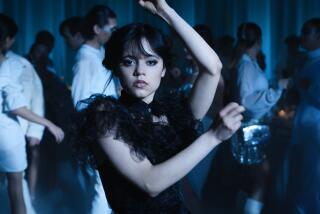TV shows make the paranormal popular
- Share via
URBANA, OHIO — As midnight approached, a grassy field where the old train depot once stood pulsed with activity.
About 90 people tiptoed around night-vision cameras atop tiny silver tripods and dodged remote sensors connected to a computerized surveillance system. They waited for the Lincoln ghost train, which some people believe passes through this western Ohio city on the anniversary of the 1865 trip that carried the president’s body to Springfield, Ill., for burial.
Ghost-hunting groups around the country are swelling with members, their popularity fueled by television shows, the Internet and the increasing availability of high-tech equipment.
“Academics pooh-pooh all of this usually,” said Julieanne Phillips, an assistant professor of American history at Urbana University here who invited the ghost hunters and organized the vigil, which also included about 80 students and residents. “I’m hoping for some vindication that there might be some type of paranormal activity surrounding this.”
On this April night, there wasn’t. “Ghost reality shows have really opened the door for people to get involved themselves,” said James Willis, founder of the Ghosts of Ohio, the group watching the tracks for the phantom funeral train.
The airwaves are populated with shows such as “Ghost Whisperer,” “Medium,” “Paranormal State” and “Ghost Hunters.”
Viewership of “Ghost Hunters,” a reality show on the Sci Fi Channel that chronicles investigations by the Atlantic Paranormal Society, or TAPS, has doubled since it debuted in 2004 -- from 1.3 million viewers to 2.6 million.
The Rhode Island-based society has about 80 affiliates in 44 states, twice the number of affiliates it had two years ago. And there are about 800 individual members within those affiliates.
“Thank God for the ‘Ghost Hunters’ on Sci Fi,” said Patti Starr, founder of Lexington, Ky.-based Ghost Chasers International. “Through that show, I think people see we are really serious about what we do, and they’ve raised the bar.”
Even the U.S. Air Force has gone along, inviting “Ghost Hunters” to investigate reports of unusual occurrences at Wright-Patterson Air Force Base near Dayton, Ohio. The episode showed a flashlight turning on by itself and unexplained knocks and door-closings. Other groups are feeling the surge of interest in ghost hunting.
A Midwest Haunting, based in Macomb, Ill., offers October tours of buildings, cemeteries and other sites it has investigated and believes to be haunted. The number of people taking the tours has tripled, from about 600 in 2006 to 1,800 last year.
Forty of the 60 people who attended a recent dinner in Erie, Pa., featuring the locally based Paranormal Study and Research Group asked if they could join the group or tag along on ghost hunts. A year earlier, only two or three had asked to be involved after a similar event.
“We’re actually grateful for [“Ghost Hunters”] because instead of being a bunch of freaks, we’re, like, the cool people on TV,” founder Pat Jones said.
Thirty-four percent of Americans say they believe in ghosts, according to a survey conducted in October by the Associated Press and Ipsos, an independent market research company.
Joe Nickell, senior research fellow with the Amherst, N.Y.-based Committee for Skeptical Inquiry, said he has investigated dozens of reported hauntings since 1969 and has turned up no evidence of ghosts.
Equipment being used to try to detect ghosts is not designed for that, Nickell said. Ghost hunters often arm themselves with electromagnetic detectors, thermometers that can identify cold spots and wireless microphones that eliminate background noise.
“The least likely explanation for any given reading is it is a ghost,” Nickell said.
More to Read
Sign up for Essential California
The most important California stories and recommendations in your inbox every morning.
You may occasionally receive promotional content from the Los Angeles Times.












